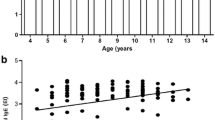Abstract
Experimentsin vitro have shown that bacteria induce histamine release and potentiate IgE-mediated histamine release. In the present study, these events were examined in allergic patients by anin vivo model using nasal challenge. Nasal spray with 56 mgStaphylococcus aureus triggered histamine release in the nasal cavity in 4 of 13 patients, whereas no response was obtained by 28 and 112 mg bacterium. These findings indicate that bacteria containing peptidoglycan may release histaminein vivo. To avoid allergens, we used anti-IgE antiserum. In six patients nasal challenge with anti-IgE (112000 IU) caused an, increased histamine level in the nasal fluid which was not obtained by a control preparation without anti-IgE antibodies. The IgE-mediated mediator release was potentiated by the bacterium in only 2 of 22 patients.
Similar content being viewed by others
References
P. Clementsen, K. S. Kristensen and S. Norn,Microorganisms and exacerbation of chronic obstructive pulmonary diseases: pathophysiological mechanisms. Allergy (in press).
S. Norn,A medical hypothesis. Bacteria-induced histamine release: possible relationship to asthma. Rev. Fr. Allergol.28, 199–203 (1988).
F. Espersen, J. O. Jarløv, C. Jensen, P. Stahl Skov and S. Norn,Staphylococcus aureus peptidoglycan induces histamine release from basophil human leukocytes in vitro. Infect. Immun.46, 710–714 (1984).
M. Andersson, H. Nolte, M. Olsson, P. Stahl Skov and U. Pipkorn,Measurement of histamine in nasal lavage fluid: comparison of a glass fiber-based flurometric method with two radioimmunoassays. J. Allergy Clin. Immunol.86, 815–820 (1990).
R. M. Naclerio, H. L. Meier, A. Kagey-Sobotka et al.,Mediator release after nasal airway challenge with allergen. Am. Rev. Respir. Dis.128, 597–602 (1983).
B. J. Howlett, R. B. Knox and J. Heslop-Harrison,Pollen-wall proteins: release of the allergen Antigen E from intine and exine sites in pollen grains of ragweed and Cosmos. J. Cell Sci.13, 603–619 (1973).
H. Løwenstein and N. Mygind,Extraction and degradation of Timothy pollen allergen during simulated in vivo conditions. Allergy33, 238–240 (1973).
P. Clementsen, N. Milman, E. Struve-Christensen et al.,Bacteria-induced histamine release from human bronchoalveolar cells and blood leukocytes. Allergy46, 45–51 (1991).
M. K. Church, S. Norn, G. J.-K. Pao and S. T. Holgate,Non-IgE-dependent bacteria-induced histamine release from human lung and tonsillar mast cells. Clin. Allergy17, 341–353 (1987).
H. W. Baenkler, H. Hosemann and F. Dechant,Bacterial induced in vitro histamine release from nasal mucosa and polyps. Ann. Allergy55, 240 (1985).
Author information
Authors and Affiliations
Rights and permissions
About this article
Cite this article
Kristensen, K.S., Dein, T., Norn, S. et al. Measurement of histamine in nasal lavage fluid after challenge with anti-IgE antibody andStaphylococcus aureus . Agents and Actions 36 (Suppl 2), C417–C420 (1992). https://doi.org/10.1007/BF01997389
Issue Date:
DOI: https://doi.org/10.1007/BF01997389




